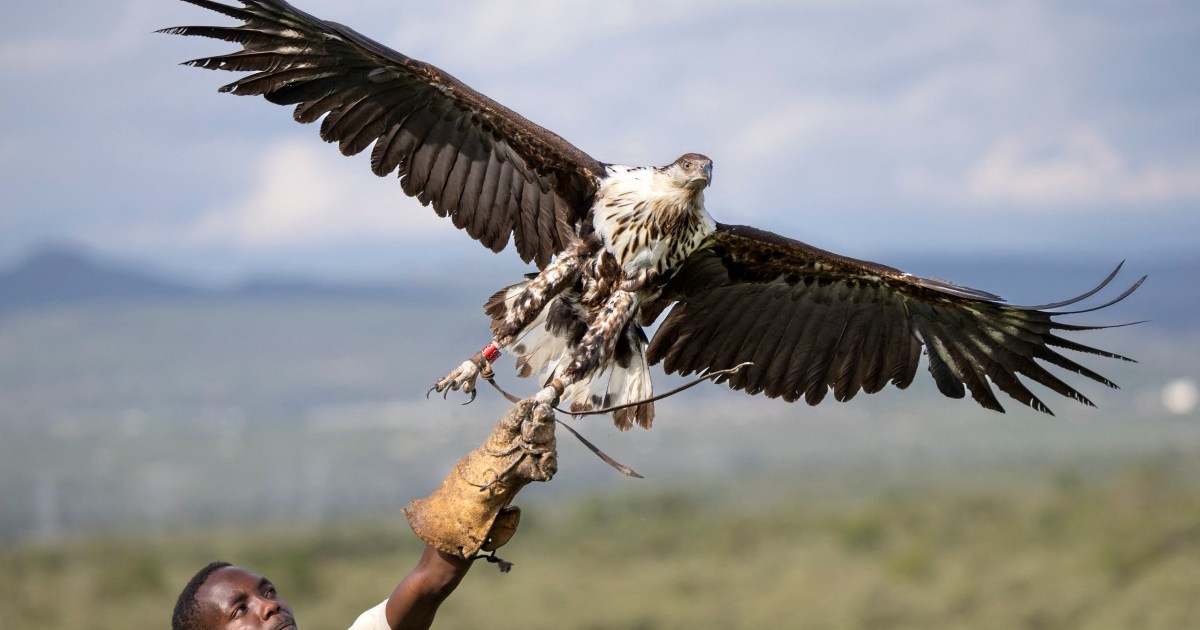Simon Thomsett tentatively removes a pink bandage from the wing of an injured bateleur, a short-tailed eagle from the African savannah, where birds of prey are increasingly at risk of extinction.
“There is still a long way to go before healing,” Thomsett explains as he lifts up the bird’s dark feathers and examines the injury.
“It was injured in the Maasai Mara national park, but we don’t know how,” says the 62-year-old vet who runs the Soysambu Raptor Centre in central Kenya.
The 18-month-old eagle, with a distinctive red beak and black body, was brought to the shelter five months ago, where about 30 other injured raptors keep it company.
The sanctuary in the Soysambu reserve is one of the few places where the birds of prey are safe.
A study published in January by The Peregrine Fund, a United States-based non-profit organisation, found that the raptor population has fallen by 90 percent on the continent over the last 40 years.
“You can go down a road today for maybe 200km [125 miles] and not see a single raptor,” Thomsett says.
“If you did that 20 years ago, you would have seen a hundred.”
The reasons for the decline are multifold.
Vultures and other scavengers have died from eating livestock remains, falling victim to a practice adopted by cattle farmers who poison carcasses to deter lions from approaching their herds.
Deforestation also plays a part as does the proliferation of power lines across Africa that prove fatal for birds who perch on them to hunt prey.
Some species are shrinking so fast that conservation initiatives will not yield results, says Thomsett. “We are too late.”
Birds of prey also suffer from an image problem.
“Vultures are seen as ugly, unsightly, dirty and disgusting,” says Shiv Kapila, who manages a bird sanctuary at the Naivasha national park which lies around 50km (31 miles) from the Soysambu reserve.
Some communities even go so far as to kill species such as owls and lappet-faced vultures, believing they bring bad luck.
“We have to convince people that not only are they absolutely gorgeous but also incredibly useful as well,” he says, as long-legged Ruppell’s vultures and pink-headed lappet-faced vultures rub shoulders inside a cage.
Educating people about birds of prey is essential, says Kapila, who organises school trips to the sanctuary and visits to local communities to shift public opinion.
“We can see a lot of difference in attitudes,” says 25-year-old vet Juliet Waiyaki, who began working at the Naivasha sanctuary last year, helping to care for the 35 birds of prey housed there.
But she sometimes questions whether her work as a vet makes an impact.
“I can’t tell you if by us saving eight vultures out of 300,000 … if that makes a difference,” Waiyaki says. “But we do our part.”
At the Naivasha sanctuary raptors can stay from just a few days to several years. Staff often travel across the country to rescue injured birds.
“We take an injured bird from the field or members of the public bring them to us and we treat them,” says Kapila, adding that 70 percent of his patients eventually recover enough to return to the wild.
Despite the massive decline in numbers, Thomsett sees “room for optimism”, especially when he thinks of injured birds that seemed to have “had no chance whatsoever … [but] are alive and well today”.
He even gets return visitors, he says, with some birds coming back to greet him years after they are released into the wild. “It is extremely rewarding,” he says.
Check out our Latest News and Follow us at Facebook
Original Source

